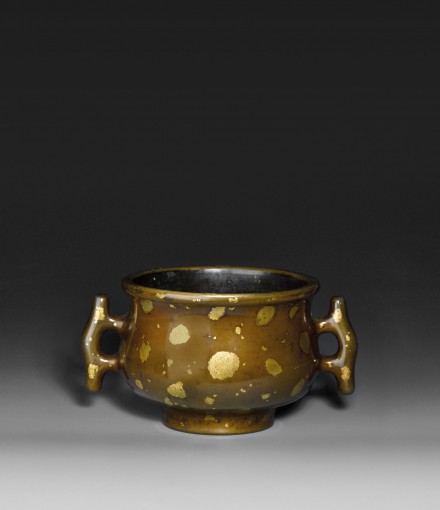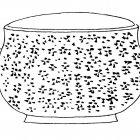J.J. Lally & Co., Oriental Art / New York City, New York
MenuPast Exhibition
Chinese Art from the Scholar’s Studio
March 13 - April 11, 2015

45.
A GOLD-SPLASHED BRONZE CENSER WITH
‘HALBERD-BLADE’ HANDLES
Ming Dynasty (1368-1644)
the heavily cast bombé sides rising to a rounded rim and resting on a ring foot, with projecting handles described by late Ming commentators as based on the shape of an ancient Chinese ji halberd, the surface with rich chocolate-brown patina embellished with large and small gold splashes on the exterior and on the recessed base.
Width over handles 7 1⁄4 inches (18.5 cm)
Provenance
Blitz Antiek en Kunsthandel, Amsterdam, 2006
Private Collection, Belgium
The shape of this censer is based on a Song dynasty ceramic prototype. Compare, for example, the Song dynasty Guan ware censer in the Cleveland Museum of Art, illustrated by Mino and Tsiang, Ice and Green Clouds: Traditions of Chinese Celadon, Indianapolis, 1986, pp.172-173, no. 68. See also a Southern Song Longquan celadon censer of similar form discovered in 1978 at Fenshantou cemetery in Shiquan village, Xia’ang county, Huzhou city, Zhejiang province and now in the collection of the Huzhou Museum, illustrated in Qing, Ya: Nan Song ciqi jingping (Pure and Elegant: Selected Southern Song Ceramics), Beijing, 2010, p. 47.
A gold-splashed bronze censer of very similar form is illustrated in a line drawing in Xuande yiqi tupu (Illustrated Catalogue of Ritual Vessels of the Xuande Period), text published circa 1600, juan 13, p. 2 (see illustration to right). The same line drawing is also illustrated for comparison to the small gold-splashed bronze censer of very similar form in the collection of the National Palace Museum, in Through the Prism of the Past: Antiquarian Trends in Chinese Art of the 16th to 18th Century, Taipei, 2004, p. 303, figs. 8 and 9.
The Xuande yiqi tupu is a major source of information on Ming dynasty bronze censers, but the reliability of the document has been questioned because, despite the fact that Xuande yiqi tupu is recorded as having been first published in the late Ming, the woodblock-printed illustrations apparently were not included until much later editions, possibly as late as the Guanxu period (1875-1908).
明 銅灑金戟耳爐 寬 18.5 厘米
Additional Images (Touch to enlarge)
45.
A GOLD-SPLASHED BRONZE CENSER WITH
‘HALBERD-BLADE’ HANDLES
Ming Dynasty (1368-1644)
Width over handles 7 1⁄4 inches (18.5 cm)
